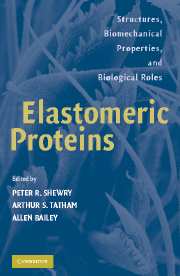Book contents
- Frontmatter
- Contents
- Preface
- Contributors
- Elastomeric Proteins
- 1 Functions of Elastomeric Proteins in Animals
- 2 Elastic Proteins: Biological Roles and Mechanical Properties
- 3 Elastin as a Self-Assembling Biomaterial
- 4 Ideal Protein Elasticity: The Elastin Models
- 5 Fibrillin: From Microfibril Assembly to Biomechanical Function
- 6 Spinning an Elastic Ribbon of Spider Silk
- 7 Sequences, Structures, and Properties of Spider Silks
- 8 The Nature of Some Spiders' Silks
- 9 Collagen: Hierarchical Structure and Viscoelastic Properties of Tendon
- 10 Collagens with Elastin- and Silk-like Domains
- 11 Conformational Compliance of Spectrins in Membrane Deformation, Morphogenesis, and Signalling
- 12 Giant Protein Titin: Structural and Functional Aspects
- 13 Structure and Function of Resilin
- 14 Gluten, the Elastomeric Protein of Wheat Seeds
- 15 Biological Liquid Crystal Elastomers
- 16 Restraining Cross-Links in Elastomeric Proteins
- 17 Comparative Structures and Properties of Elastic Proteins
- 18 Mechanical Applications of Elastomeric Proteins – A Biomimetic Approach
- 19 Biomimetics of Elastomeric Proteins in Medicine
- Index
8 - The Nature of Some Spiders' Silks
Published online by Cambridge University Press: 13 August 2009
- Frontmatter
- Contents
- Preface
- Contributors
- Elastomeric Proteins
- 1 Functions of Elastomeric Proteins in Animals
- 2 Elastic Proteins: Biological Roles and Mechanical Properties
- 3 Elastin as a Self-Assembling Biomaterial
- 4 Ideal Protein Elasticity: The Elastin Models
- 5 Fibrillin: From Microfibril Assembly to Biomechanical Function
- 6 Spinning an Elastic Ribbon of Spider Silk
- 7 Sequences, Structures, and Properties of Spider Silks
- 8 The Nature of Some Spiders' Silks
- 9 Collagen: Hierarchical Structure and Viscoelastic Properties of Tendon
- 10 Collagens with Elastin- and Silk-like Domains
- 11 Conformational Compliance of Spectrins in Membrane Deformation, Morphogenesis, and Signalling
- 12 Giant Protein Titin: Structural and Functional Aspects
- 13 Structure and Function of Resilin
- 14 Gluten, the Elastomeric Protein of Wheat Seeds
- 15 Biological Liquid Crystal Elastomers
- 16 Restraining Cross-Links in Elastomeric Proteins
- 17 Comparative Structures and Properties of Elastic Proteins
- 18 Mechanical Applications of Elastomeric Proteins – A Biomimetic Approach
- 19 Biomimetics of Elastomeric Proteins in Medicine
- Index
Summary
INTRODUCTION
Lepidopteran silk has a long tradition of commercial exploitation (Anquetil and Walter, 1996). The traditional standing of spider silk, on the other hand, has until now been mainly that of a mystical material made by a rather dubious creature (Hilliard, 1994). Recently, however, spider silks have attracted considerable attention as potential blueprints for designing modern ‘techno-fibres’ (Vollrath and Knight, 2001). Web silks have unusual characteristics for structural proteins. Instead of growing inside the body, they are extruded and body contact is not important for their function. Moreover, most silks function best in the dry and not in the aqueous state. A single fibre typically is of considerable purity and is many hundreds of meters long. Indeed, a single fibre is also thick enough to be handled, allowing its mechanical properties to be measured and analysed with traditional methods (Madsen et al., 1999). Finally, partly because of their proven commercial track record, silks have attracted considerable attention and funding. Hence, novel insights are rapidly accumulating (Kaplan et al., 1994); especially in the areas of silk genomics (e.g., Prince et al., 1995; Guerette et al., 1996; Lewis, 1999; Hayashi and Lewis, 2000), silk chemistry (Lewis, 1992; Winkler and Kaplan, 2000), silk structure (Grubb and Jelinski, 1997; Beek et al., 1999; Sirichaisit et al., 1999; Riekel and Vollrath, 2001), silk spinning (Knight and Vollrath, 1999b, 2001a, 2001b), silk mechanics (Thiel and Kunkel, 1994a; Vollrath et al., 2001), silk modelling (Fossey and Kaplan, 1994; Gosline et al., 1994; Termonia, 1994; Thiel and Viney, 1995), and silk copying (O'Brien et al., 1994, 1998; Lazaris et al., 2002).
- Type
- Chapter
- Information
- Elastomeric ProteinsStructures, Biomechanical Properties, and Biological Roles, pp. 152 - 174Publisher: Cambridge University PressPrint publication year: 2003
- 3
- Cited by

